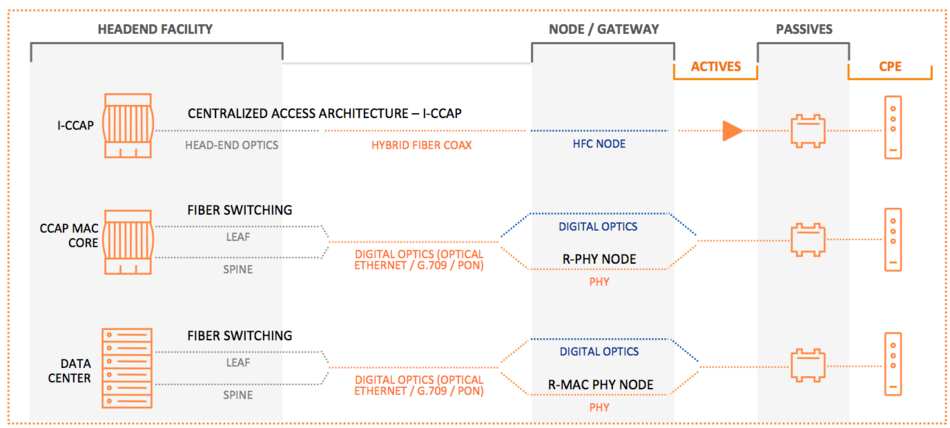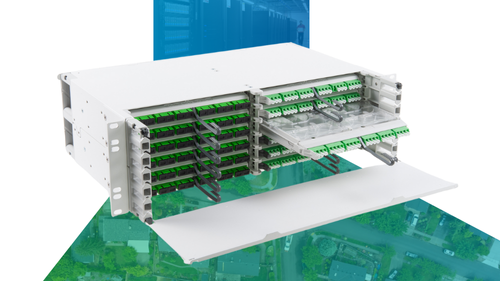DAA stands for Distributed Access Architecture, an approach to upgrading broadband networks. It’s helpful to understand how modern networks are organized before diving into how distributed architectures help improve them.
HFC Networks
Today, the majority of cable networks delivering broadband internet are HFC (Hybrid Fiber Coaxial) networks. Like the name implies, these networks contain a hybrid of both coaxial cable—the traditional form of cabling used to distribute both TV and broadband internet to consumers—and the newer fiber optic infrastructure.
Fiber optic cable is capable of supporting much broader spectra and, as a result, more bandwidth capacity than coaxial cable. It will likely be the technology of choice for broadband connectivity in the distant future. However, it is also expensive to install. For most brownfield areas where HFC is the existing infrastructure already in place, pulling fiber all the way to the homes requires a significant investment from the operators. Because it is not economically feasible for most cable operators to simply tear out all their coaxial cables in a network and replace them with Ethernet or PON-based fiber all at once, each operator is developing a unique strategy for migrating from their specific mix of fiber and coaxial infrastructure to an all-fiber solution in the future. This all-fiber solution is known as fiber-to-the-home (FTTH), but it is not likely that all operators can afford to get there in the near future. That’s where DAA comes in with a beautiful transition strategy.
Distributed Access Architectures
DAA allows operators to push the functionality of their headend—the part of the network that originates video and broadband services—deeper into the network and closer to the end user. In particular, it can push pieces of the headend functionality into the fiber-optic node, where the fiber and coaxial parts of the HFC network meet. In all DAA solutions, operators are replacing analog fiber in their network with digital fiber (typically carrying Ethernet or PON signals). This transitional step is directionally correct for the networks of the future, because (like FTTH) it begins to move Ethernet and PON closer to homes; however it does not force the operators to incur the significant investment costs associated with a full FTTH deployment. Operators can elect to pull the fiber only as deep as required (and as deep as they can afford) at any point in time. Many are choosing to continue to operate with Node+X solutions, with X=2 or 3 or 4 amplifiers being placed within the coaxial amplifier cascade that lies south of the fiber-optic node.
By adopting this digital fiber-based architecture for distributing headend functionality deeper into the access network, operators can significantly improve effective broadband speeds and lower space, power, and cooling costs within the headend. They also open the door to virtualizing headend and network functions in the future. Perhaps most importantly, operators can achieve these advantages without having to overhaul large portions of their existing network infrastructure. This re-use of already-deployed resources is appealing because it allows operators to deliver on the promise of future 10G services, while preserving the value of their existing hardware investments and running their networks more efficiently.
CLICK TO TWEET: Do you know how broadband networks of the future are designed? It's called distributed access architecture. Learn about it here.
R-PHY and MACPHY
As DAA has evolved over the years, two major models have emerged for distributing components of network functionality closer to the end user. The two variants of DAA include:
- Remote PHY
- Remote MACPHY.
For Remote PHY (R-PHY) solutions, only the PHY portion of the headend is pushed into the fiber-optic node. This PHY portion of the headend performs the DSP and analog processing functions needed to create the RF signals that will propagate across the HFC plant. For Remote MACPHY solutions, the PHY portion plus the MAC portion of the headend is pushed into the fiber-optic node. This MACPHY functionality performs the PHY functionality described above, but it also filters and schedules packets for delivery over the HFC plant. Different operators will likely select different paths as they evaluate the two DAA variants listed above. Many operators selected Remote PHY solutions in the early days of DAA deployments because it was easier for system vendors to build Remote PHY products that stayed within the thermal and power constraints of the existing nodes. However, Moore’s Law improvements in silicon devices have eased many of those thermal and power constraints, so Remote MACPHY solutions are now becoming much more prevalent in the marketplace and garnering more and more interest from the operator community. How these two approaches compare is beyond the scope of this article, but they offer operators choice in upgrading according to their network and their needs.
To find out more about DAA, please visit our Distributed Access Architecture website here.















